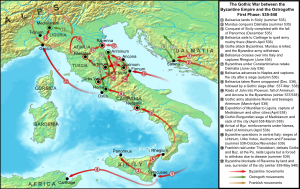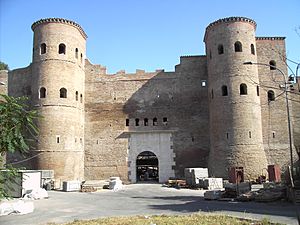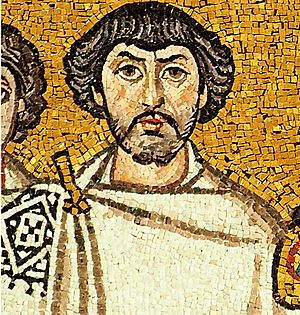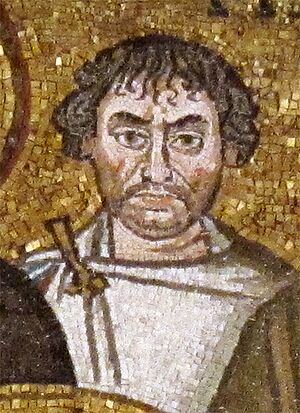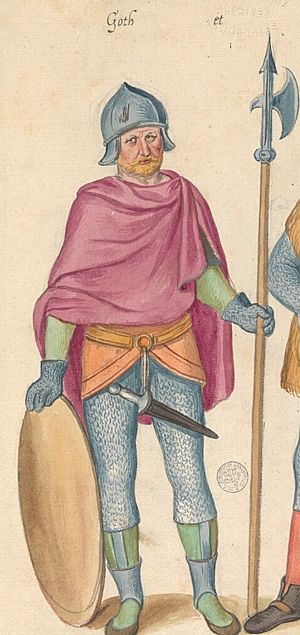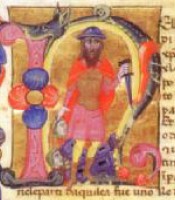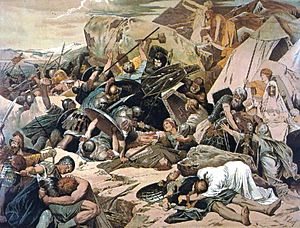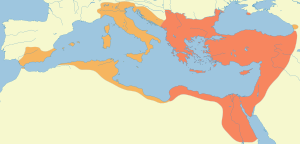Gothic War (535–554) facts for kids
Quick facts for kids Gothic War |
|||||||||
|---|---|---|---|---|---|---|---|---|---|
| Part of Justinian's Renovatio Imperii | |||||||||
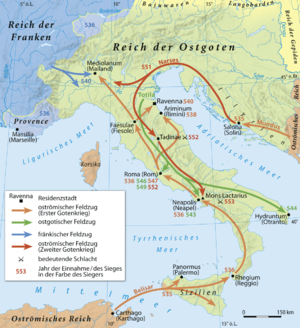 |
|||||||||
|
|||||||||
| Belligerents | |||||||||
| Eastern Roman Empire Huns Heruli Sclaveni Lombards |
Ostrogoths Franks Alamanni Burgundians Visigoths |
||||||||
| Commanders and leaders | |||||||||
| Justinian Belisarius Calonymus Mundus † John Narses Bessas Germanus Liberius Conon Artabazes Constantinianus Vitalius Cyprian Bochas Chalazar Odolgan Uldach |
Theodahad Vitiges Ildibad Eraric Totila † Teia † Uraias Uligisalus Asinarius Indulf Scipuar Gibal Butilinus |
||||||||
The Gothic War was a long and difficult fight between the Eastern Roman Empire (also known as the Byzantine Empire) and the Ostrogothic Kingdom in Italy. It lasted from 535 to 554 AD. This war happened mostly in Italy, but also in places like Sicily and Dalmatia. It was one of the last big wars between the Goths and the Roman Empire.
The war started because the Byzantine Emperor Justinian I wanted to take back lands that the old Western Roman Empire had lost. These lands had been taken over by different barbarian tribes. Justinian had already won back the province of Africa from the Vandals.
Historians usually divide the Gothic War into two main parts:
- First Phase (535–540): This part ended when the Ostrogothic capital, Ravenna, was captured. It looked like the Byzantines had won Italy.
- Second Phase (540/541–553): The Goths made a comeback under a new leader named Totila. The Byzantine general Narses finally defeated them after a long struggle. Narses also stopped an invasion by the Franks and Alamanni in 554.
After the war, Justinian set up a new government for Italy. However, some cities in northern Italy kept fighting until 562. The war left Italy in ruins and many people had died. It was a very costly victory for the Byzantines. Just a few years later, in 568, the Lombards invaded, and the Byzantine Empire lost control of much of Italy for good.
Contents
How the War Started
Italy Under Gothic Rule
In 476 AD, a leader named Odoacer removed the last Western Roman Emperor in Italy. He declared himself the "King of Italy." Even though Odoacer said he respected the Eastern Roman Emperor, Zeno, his growing power worried Constantinople.
To deal with Odoacer, Zeno sent the Ostrogoths, led by Theodoric the Great, to Italy. The Ostrogoths were allies of the Empire. Theodoric defeated Odoacer, and Italy came under Gothic rule. Theodoric acted as a representative of the Empire, leading the army. Romans still handled the government. The Goths were Arian Christians, while the Romans were Chalcedonian Christians. Theodoric allowed people to practice their own religion. This system worked well while Theodoric was alive.
After Theodoric died in 526, his grandson Athalaric became king at age 10. His mother, Amalasuntha, ruled for him. She was educated in Roman ways and tried to make peace with the Roman leaders and the Byzantine Empire. This made some Gothic nobles unhappy. Amalasuntha had some of these nobles killed and even asked Emperor Justinian for safety if she was removed from power.
Belisarius and the Invasion
In 533, Emperor Justinian sent his best general, Belisarius, to take back North Africa from the Vandals. Belisarius won quickly, which made Justinian want to take back even more lost Roman lands.
Amalasuntha had allowed the Byzantine fleet to use harbors in Sicily, which belonged to the Ostrogothic Kingdom. When her son Athalaric died in 534, Amalasuntha made her cousin Theodahad king. But Theodahad arrested her and had her killed in early 535. Justinian tried to save her, but it was too late. Her death gave Justinian a reason to start a war with the Goths.
Belisarius was put in charge of the invasion of Italy. He had about 7,500 soldiers. Another general, Mundus, was ordered to take the Gothic province of Dalmatia. Justinian also secretly sent gold to the Franks to keep them neutral.
First Byzantine Campaign (535–540)
Taking Sicily and Dalmatia
Belisarius landed in Sicily, an island between Roman Africa and Italy. The people there were friendly to the Empire. Sicily was quickly captured, with the last resistance at Panormus (Palermo) falling by December. Belisarius then got ready to cross into Italy.
Meanwhile, in March 536, Mundus captured Dalmatia and its capital, Salona. But a large Gothic army arrived, and Mundus's son died in a fight. Mundus defeated the Goths but was also badly wounded and died. The Roman army pulled back, and the Goths took back most of Dalmatia.
Encouraged, Theodahad put the Byzantine ambassadors in prison. Justinian sent a new general, Constantinianus, to take back Dalmatia. He also told Belisarius to invade Italy. Constantinianus quickly succeeded. The Goths left Salona, and by late June, all of Dalmatia was back in Roman hands.
First Siege of Rome
In the spring of 536, Belisarius crossed into Italy. He captured Rhegium and moved north. The city of Neapolis (modern Naples) was besieged for three weeks before the Byzantine troops broke in during November. The city was sacked.
Belisarius then moved to Rome. Seeing what happened to Naples, Rome did not fight back. Belisarius entered the city without opposition in December. The Goths were surprised by how fast the Byzantines moved. They were also angry at Theodahad for doing nothing. He was removed from power and replaced by Vitiges.
Vitiges left Rome for Ravenna, where he married Amalasuntha's daughter, Matasuntha. He then gathered a large army and marched against Rome. Belisarius did not have enough troops to fight the Goths in an open battle, so he stayed inside Rome. The siege lasted from March 537 to March 538. There were many small battles. After more Byzantine troops arrived, Belisarius's army went on the attack. The Byzantine navy cut off Gothic supplies by sea. When the city of Ariminum (modern Rimini) fell, Vitiges had to give up the siege and retreat.
Siege of Ariminum
As Vitiges marched northeast, he left soldiers in towns and forts to protect his army. He then turned towards Ariminum. A Roman force of 2,000 horsemen, some of Belisarius's best, was holding the city. Their commander, John, refused to leave.
Soon after, the Goths attacked Ariminum but failed. However, the city had little food. A new Byzantine force of 2,000 soldiers, led by the general Narses, arrived. Belisarius and Narses met. Narses wanted to go straight to Ariminum, while Belisarius wanted to be more careful. A letter from John, saying the city was in great danger, made them decide to help.
Belisarius split his army into three parts. One went by sea, another from the south, and the main force, led by him and Narses, came from the northwest. When Vitiges learned they were coming, he quickly retreated to Ravenna to avoid being surrounded.
This victory at Ariminum, without a fight, made Narses more popular than Belisarius. Many Roman generals started to follow Narses. After Ariminum, Belisarius wanted to capture the Gothic strongholds of Auximum and relieve the siege of Mediolanum. Narses wanted to spread out their efforts. Belisarius did not let this disagreement last. He marched with Narses and John against Urbinum. Narses soon left, thinking the town was too strong. But Urbinum fell to Belisarius when its only water spring dried up.
Mediolanum Falls
In April 538, people from Mediolanum (Milan), the second-largest city in Italy, asked Belisarius for help. He sent 1,000 men under Mundilas to the city. This force easily secured Milan and most of the surrounding area.
Vitiges asked the Franks for help. A large force of 10,000 Burgundians crossed the Alps. They joined with the Goths and laid siege to Milan. Milan was not well prepared and had few soldiers. The small Roman force had been spread out to protect other towns.
Belisarius sent a relief force, but its commanders did not help the besieged city. They waited for more soldiers from other generals. This delay was deadly for Milan. After many months, the city was starving. The Goths offered to spare the soldiers if they surrendered, but not the people. The Roman commander refused. By March 539, his starving soldiers forced him to accept. The Roman soldiers were spared, but the people of Milan were massacred, and the city was destroyed.
Frankish Invasion
After the disaster at Milan, Narses was called back, and Belisarius became the supreme commander in Italy. Vitiges sent messengers to the Persian court. He hoped to convince the Persian king to start a war with the Byzantines. This would force Justinian to send most of his troops, including Belisarius, to the east, allowing the Goths to recover.
Belisarius decided to end the war by taking Ravenna. But first, he had to deal with the Gothic strongholds of Auximum (modern Osimo) and Faesulae (Fiesole). While some Byzantine forces stopped the Gothic army from crossing the River Po, Belisarius besieged Auximum.
During these sieges, a large Frankish army, led by King Theudebert I, crossed the Alps. They attacked the Goths, who thought they were allies, and quickly defeated them. The Byzantines were also surprised and defeated, retreating south. The Frankish invasion ended when many of their soldiers got sick with dysentery, forcing them to leave. Belisarius then focused on the besieged cities. Both Auximum and Faesulae surrendered in late 539 because of starvation.
Ravenna Captured
More Byzantine troops arrived, and Belisarius moved against Ravenna. His forces cut off the city from supplies by land and sea. Inside Ravenna, Vitiges received an offer from Justinian. The Emperor wanted to end the war quickly because of the coming Persian war. He offered to divide Italy: the Byzantines would keep the lands south of the Po River, and the Goths would keep the lands north of it.
The Goths quickly accepted these terms. But Belisarius refused to sign the agreement. He felt it would betray all his hard work. The Goths, who respected Belisarius, then offered to make him the Western Emperor. Belisarius pretended to accept this offer, seeing a way to win.
In May 540, Belisarius and his army entered Ravenna. The city was not looted. The Goths were treated well and allowed to keep their property. After Ravenna surrendered, many Gothic garrisons north of the Po also gave up. Belisarius then sailed back to Constantinople. He was not given a special victory parade. Vitiges was given a comfortable retirement, and the captured Goths were sent to join the Byzantine armies in the east.
Gothic Comeback (541–551)
Belisarius's departure left most of Italy in Roman hands. But north of the Po, Pavia (the new Gothic capital) and Verona were still unconquered. The Goths chose Ildibad as their new king. He quickly took back control of Venetia and Liguria.
Justinian did not appoint a new overall commander for Italy. The Roman armies became undisciplined and started looting. The new Byzantine government also became unpopular because it demanded high taxes. Ildibad defeated the Roman general Vitalius. But after Ildibad had another Gothic leader killed, he was also assassinated in May 541.
The Goths then chose Eraric as their new king. Eraric secretly planned to hand over his kingdom to the Byzantines. The Goths realized this and turned to Ildibad's nephew, Totila. Totila agreed to become king. In the autumn of 541, Eraric was murdered, and Totila became king.
Totila's Early Victories
Totila had several advantages. The terrible Plague of Justinian broke out in 542, killing many people across the Byzantine Empire. This weakened the Empire. Also, a new war with Persia forced Justinian to send most of his troops to the east. Finally, the Byzantine generals in Italy were not working together.
This disunity led to Totila's first success. The Byzantine generals tried to capture Verona. They got inside a gate through a trick, but then they argued over who would get the loot. This allowed the Goths to take back the gate. Totila then attacked their camp near Faventia (Faenza) and destroyed the Roman army at the Battle of Faventia.
Totila marched into Tuscany and besieged Florence. The Roman generals tried to help Florence, but their larger forces were defeated at the Battle of Mucellium.
Taking Southern Italy
Totila then marched south, avoiding Rome. The Roman garrisons there were small and weak. He quickly took control of the countryside, leaving the Byzantines only in isolated forts, mostly on the coast. When a fort fell, its walls were usually torn down so it could not be used again.
Totila treated his captives well. This encouraged his enemies to surrender instead of fighting to the end. He also tried to win over the Italian people. For example, during the Siege of Naples in 543, he allowed the city to surrender on fair terms. He even helped the starving citizens get back their strength before letting the Byzantine soldiers leave safely.
After capturing Naples, Totila tried to make peace with Justinian, but the Emperor refused. Totila then posted copies of his peace offer all over Rome. Even though people were unhappy with the Byzantines, no one in Rome rose up to support Totila. He then marched north and besieged Rome.
Rome Falls Again
In 544, Belisarius was sent back to Italy with 200 ships. He took back much of southern Italy. But, according to a historian named Procopius, Justinian did not send him enough supplies or soldiers. So Belisarius felt he could not march to help Rome.
Procopius described a terrible famine during the siege of Rome. Ordinary Romans, who could not afford grain, ate bran, nettles, dogs, mice, and even "each other's dung." The Pope sent ships with grain, but Totila's navy captured them. Belisarius tried desperately to relieve Rome but failed.
After more than a year, Totila finally entered Rome on December 17, 546. His men climbed the walls at night and opened the Asinarian Gate. Procopius says some Byzantine soldiers helped Totila. Rome was looted. Totila had wanted to destroy the city completely, but he only tore down about one-third of its walls. He then left to chase Byzantine forces in Apulia.
Belisarius successfully took back Rome four months later, in the spring of 547. He quickly rebuilt the damaged parts of the walls. Totila returned but could not defeat the defenders. Belisarius did not follow up his victory. Several cities were taken by the Goths, while Belisarius remained inactive. He was then called back from Italy.
In 549, Totila attacked Rome again. He tried to storm the walls but was pushed back. He then planned to blockade the city and starve the defenders. However, the Byzantine commander had stored a lot of food and even planted wheat fields inside the city. But Totila managed to bribe some of the soldiers guarding the city. They opened the Porta Ostiensis gate for him. Totila's men swept through the city, killing everyone except women, who were spared. They looted what riches were left. Totila set traps on the roads leading out of Rome, and many people were killed while trying to escape.
Byzantine Victory (551–554)
In 550–51, the Byzantines gathered a large army of 20,000 to 25,000 men. This army included regular Byzantine soldiers and many foreign allies like Lombards and Bulgars. Narses, a high-ranking official, was chosen to lead them in mid-551.
The next spring, Narses led his army along the Adriatic coast to Ancona. Then he marched inland towards Rome. Near the village of Taginae, the Byzantines met the Ostrogothic army, led by Totila. Totila tried to trick Narses into negotiations while planning a surprise attack. But Narses was too smart and set up his army in a strong defensive position.
After his reinforcements arrived, Totila launched a sudden attack at the Battle of Taginae. His cavalry charged the Byzantine center. The attack failed, and by evening, the Ostrogoths had broken and fled. Totila was killed during the retreat. The Goths holding Rome surrendered. At the Battle of Mons Lactarius in October 553, Narses defeated Teia, the last Gothic king, and the last of the Gothic army in Italy.
Even though the Ostrogoths were defeated, Narses still had to face other barbarian groups. In early 553, an army of about thirty thousand Franks and Alemanni crossed the Alps and took the town of Parma. Many Goths from northern Italy joined them. Narses had spread his troops out across central Italy.
After causing much destruction, the barbarians were finally met in battle by Narses near the river Volturnus. In the Battle of the Volturnus, the Byzantine soldiers held strong against a fierce Frankish attack. The Byzantine cavalry then surrounded the enemy. Almost all the Franks and Alemanni were wiped out. Seven thousand Goths held out near Naples until they surrendered in the spring of 555. Some lands north of the Po River were still held by Franks, Alemanni, and Goths. It was not until 562 that their last strongholds, Verona and Brixia, were captured. According to the Byzantine historian Procopius, the barbarian people were then allowed to live peacefully in Italy under Roman rule.
What Happened After
The Gothic War is often seen as a very costly victory. It used up many of the Byzantine Empire's resources. These resources might have been better used against other threats in the east and the Balkans.
Some historians have a different view. They blame the Plague of Justinian (540–541) more for the Empire's problems. This plague killed a huge part of the population during the war. It greatly reduced the Empire's workforce and tax money. They argue that no ruler could have stopped the plague, and it would have been bad for the Empire and Italy no matter what. However, the constant fighting in Italy during the war also caused many deaths.
In Italy, the war destroyed the cities and the way of life that depended on the countryside. Many great cities were abandoned as Italy entered a long period of decline. Italy became poor, and the Empire could not afford to keep its gains. Just three years after Justinian died in 565, the mainland Italian lands fell to the Germanic Lombards. Only a strip of land across central Italy and parts of southern Italy remained under Byzantine control. After the Gothic Wars, the Empire did not try to conquer the West again. Rome stayed under Byzantine control until 751. Some coastal areas of southern Italy remained under Byzantine influence until the late 11th century.
A major result of the war was that Italy, which had been united for centuries, was broken up. Different states often fought each other. Italy would not be united again until the 19th century. The widespread destruction, harsh punishments, and heavy taxes made the Italian people change their loyalties. Instead of being loyal to the Empire, they became more loyal to their religion, family, and city.
See also
 In Spanish: Guerra gótica (535-554) para niños
In Spanish: Guerra gótica (535-554) para niños



